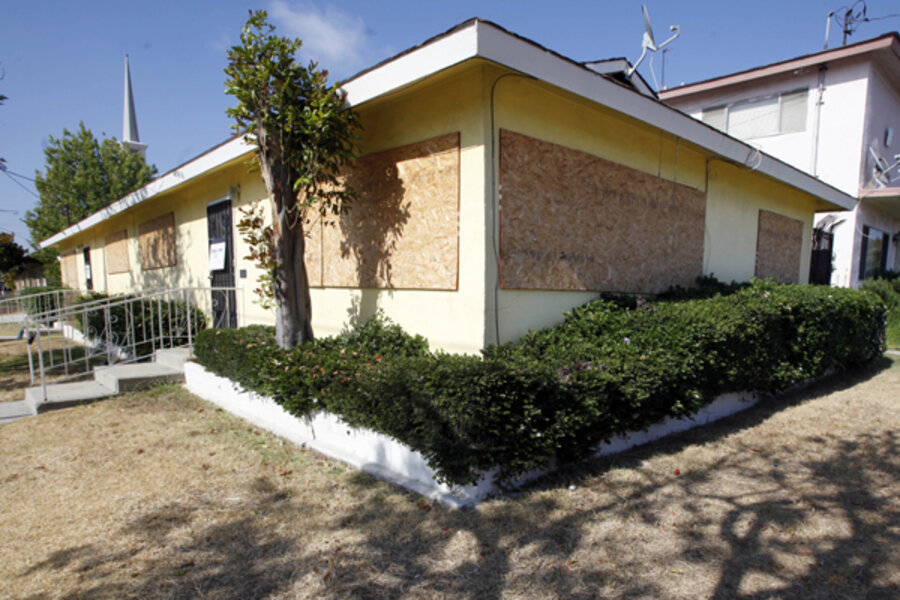Unemployed homeowners to get extra foreclosure aid
Loading...
Unemployed homeowners facing foreclosure were offered some relief on Wednesday when the Obama administration announced that it would extend an additional $3 billion to support foreclosure-prevention programs.
Some consumer-lending and housing advocates applauded the administration's expansion of housing aid to the unemployed.
“The biggest single cause of foreclosure today is loss of income or employment-related issues,” not expensive, subprime loans, says Barry Zigas, director of housing policy for the Consumer Federation of America.
The new programs will reach beyond the administration’s loan-modification program, which was designed to mitigate the subprime crisis and offers little assistance to unemployed homeowners with diminished income. Currently, unemployed homeowners are offered a three-month forbearance period to find work and become eligible for a modification.
With the unemployment rate stuck at 9.5 percent and the average length of unemployment at 24 weeks – nearly six months – the administration was criticized for not doing enough to help unemployed homeowners.
The increased aid was allocated as part of the financial-reform bill signed into law last month. A third of the additional aid will go towards funding a new bridge-loan program for homeowners with reduced incomes in hard hit local areas, although those regions have not yet been specified. The program extends a no-interest loan of up to $50,000, which can last as long as 24 months, to assist homeowners with mortgage payments until they become financially stable.
The new federal initiative is modeled on a similar state program in Pennsylvania, which has extended loans to help unemployed homeowners since 1983. Some 45,000 Pennsylvania homeowners have taken advantage of that program successfully, according to the Philadelphia Unemployment Project (PUP), a community organization that’s lobbied for the initiative to be adopted nationally.
“More money has been repaid in Pennsylvania than paid out through the program,” says John Dodds, director of PUP.
The success of the program nationally will depend largely on how well it’s implemented, says Mr. Dodds.
“We don’t want to force [homeowners] to repay the loan until they get back on their feet,” he says. “The repayment needs to be done carefully so you don’t drive people back under again.”
The pool available for bridge loans will also likely have to expand, says Dodds, considering the number of people facing foreclosure (more than 2 million in June, according to RealtyTrac) and the unprecedented length of unemployment.
Treasury must also be sensitive when determining how to distribute the funds, says Lew Finfer, of with the PICO National Network, a group that’s pushed for increased foreclosure prevention assistance.
If only metropolitan areas or larger regions with high unemployment rates are considered, says Mr. Finfer, neighborhoods and smaller cities with high foreclosure rates could be left behind.
“The program has to be flexible,” says Finfer. “It needs to be done very thoughtfully and sensitively; there are a number of different variables to take account of.”
Finfer has been critical of the administration’s so-called "Hardest Hit Fund," which since February has targeted states with the highest foreclosure rates, providing aid to help cover homes that aren’t covered by its loan-modification program. That has included measures to assist in principal reduction and smaller bridge loan programs for the unemployed.
“There’s a reason to give more funds to states that have the biggest problems,” acknowledges Finfer. “But it seems inequitable that it’s all or nothing.”
The fund will continue, though, and has been extended to 17 states and the District of Columbia, up from just 10 original states. It now includes all states that have seen unemployment rates at or above the national average over the past year. An additional $2 billion funds will go towards expanding the Hardest Hit Fund.
Other changes to the administration's loan-modification program earlier this summer targeted homeowners who are 'underwater,' owing more than their houses are worth. Banks are now offered financial incentives to reduce principal on such mortgages, and underwater homeowners not yet in arrears on their loans can apply to refinance with an FHA mortgage.





